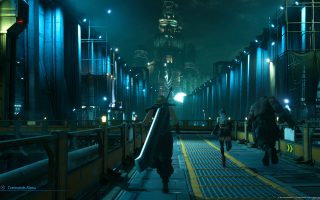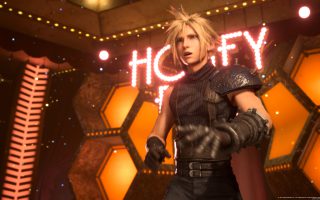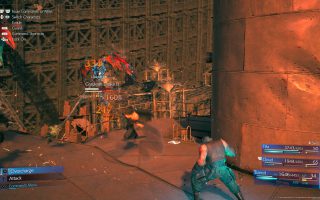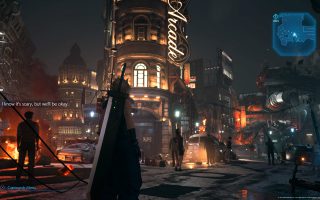Final Fantasy VII Remake Review $59.99
When Midgar's in the sky like a big pizza pie, thats amore
For nearly as long as I can remember, when following video game culture it feels like there has been a call for Final Fantasy VII to be remade with modern technology. I found this sentiment somewhat absurd, why would you ask for a remake of FFVII when Kingdom Hearts 2 ends with such a cliffhanger???? Well, having played last year’s Kingdom Hearts 3 and this year’s newly released Final Fantasy VII Remake, I can say, I was a fool.
There will be spoilers in this review
There are so many things to talk about with this Remake that it’s hard to know where to begin. I could talk about the way they’ve poorly communicated what this game is, (merely the Midgar portion of the story) or about the amazing combat system, or even the ways they’ve expanded and changed the story. If there is one thing I can confidently say about this game, it’s that SquareEnix has justified its existence. Will I eat my words when the next installment releases? I hope not, but Nomura has hurt me before.
One of the most ambitious but misleading aspects of this release is the fact that it is only a fraction of the original game, despite no clear messaging in the naming. A story that takes about six-to-eight hours in the original game now takes upwards of 30 hours to completely unfold. It’s a bold choice that leaves more unanswered questions than you might have expected for a game that is more than twenty years old. This game is setting the scene for a bigger adventure, much like the Midgar Section of the original game did. We just don’t get to play that bigger adventure. At least, not yet.
Instead, we get to spend a lot of time developing characters, and relationships. Jessie, Biggs, and Wedge, members of Avalanche who were bit characters in the original, become deep and complex characters worth spending hours of game time with. Breaking into Jessie’s parent’s house to steal a keycard from her comatose father helps bring the stakes and motivations of individual characters into perspective. And it’s a brand new piece of story that wasn’t in the original release. It puts a human face on the abstract issue of Shinra using Mako energy and lets us see the consequences and dangers of what Shinra does early in the game. Because they decided to expand and focus on the Midgar section of the game, I feel a connection to the world and characters that I never got from the original game. At least not from Midgar alone.
While the expansion of the story does add new depth to our relationships with characters it can also occasionally drag things down a bit in terms of pacing. While racing to stop Shinra from enacting an evil scheme, Cloud and friends need to fight their way through a haunted trainyard. It added nearly nothing to the story but took a significant amount of time to do. Thankfully these moments of poor pacing are few, and mainly minor blemishes on an otherwise interesting story.What makes the story stand out is the same thing that I believe justifies this game’s existence. It’s the changes, not additions. During your first mission as Cloud, bombing a Mako reactor along the edge of Midgar you start having hallucinations and flashbacks. Some of them scenes which will be familiar to fans of the original and some of them created whole cloth for this release. For newcomers to the story, many of these will lead to unanswered questions. But what is truly interesting is when we catch glimpses of the future. Again, these will mean nothing to newcomers, but for those familiar with the story, they reveal that this is not a simple retelling of the events you know. I was shook when I saw the first glimpse of Aerith’s death, as well as the final shot of the original game. But the seed is planted, telling us that things don’t have to unfold the same way they did back when we first played the PS1 game.
 An exciting and interesting new story doesn’t mean very much if the experience of playing the game is a slog, though. For the most part, playing FFVII Remake is a good time. But, some moments call back to the original Playstation game in frustrating ways. Pushing boxes is painfully slow, as is anything regarding hanging from a ceiling fixture. Animations are painfully long and drawn out for no real reason. Late in the game, deep in Hojo’s lab in Shinra tower, Red XIII will assist you by pulling levers on unreachable platforms. It just takes him about five seconds to slowly walk into position and sit down before you can instruct him to do anything. Why do I need to sit through this whole animation cycle? Why do I need to hold a button to open a door or flip a switch? It feels unnecessarily cumbersome for no reason, especially for a game released in 2020.
An exciting and interesting new story doesn’t mean very much if the experience of playing the game is a slog, though. For the most part, playing FFVII Remake is a good time. But, some moments call back to the original Playstation game in frustrating ways. Pushing boxes is painfully slow, as is anything regarding hanging from a ceiling fixture. Animations are painfully long and drawn out for no real reason. Late in the game, deep in Hojo’s lab in Shinra tower, Red XIII will assist you by pulling levers on unreachable platforms. It just takes him about five seconds to slowly walk into position and sit down before you can instruct him to do anything. Why do I need to sit through this whole animation cycle? Why do I need to hold a button to open a door or flip a switch? It feels unnecessarily cumbersome for no reason, especially for a game released in 2020.
What makes it all the more surprising is that the combat is incredibly fun and fluid in comparison. Attacks are quick, and Cloud’s iconic buster sword feels as heavy as it looks, even if he does wield it effortlessly. And each character in your party can fit into distinct roles depending on how you think they would best perform. This is aided by the materia system which is largely the same as it was in the original game, at least to how I remember it.
Materia is crystalized Mako, the lifeblood of the planet. By slotting it into weapons and armor, wielders gain the ability to cast magic – like fire or cure – or other special abilities that could mean life or death in battle. Evenly distributing your materia among your party members is a tricky balancing act, as you gain new materia but lack any new slots to slot it into. You can upgrade your weapons to gain more materia slots or find new armor with more slots in it. Materia, paired with the new weapon upgrade system, gives you many options for customizing your character’s role throughout the game, without ever feeling like you made an irreversibly bad choice. Every weapon is viable throughout the entirety of the game. Each one caters to a different play style so you can outfit your party as you see fit.
The ability to freely switch between characters during combat is the highlight of the system, as each character controls distinctly and has individualized characteristics and abilities that make them suitable for different encounters. Cloud’s abilities focus on his iconic oversized-sword; Barret has a mixture of ranged, melee, and defensive abilities; Tifa’s abilities power her up, or can be mixed into her standard attacks to create something similar to fighting game combos; Aerith has a variety of magical abilities that aid the team and crush enemies.
Most standard combat encounters are too short to warrant much strategic thought (although later battles will require you to consider weaknesses), the boss battles are where the combat system truly begins to shine. Each one brings a unique mechanic for you to learn and overcome. A somewhat early example of this is the Airbuster fight. As Shinra security forces prepare the Airbuster for combat against Avalanche, Cloud can divert components like bombs or AI cores from the boss to weaken it in the approaching fight. By doing this you reduce the lethality and speed of the Airbuster, giving you a better chance in the fight. There are plenty of other great bosses too, especially ones that feature human-sized enemies. There’s nothing scarier than a boss that’s the same size as you.
Another integral part of the game is the music. Throughout the game are reimagined versions of the original soundtrack and an occasional outburst from Barret as he triumphantly bellows the victory fanfare after battles. While I, personally, don’t have an overabundance of nostalgia for the original game or its soundtrack, certain tracks and moments did bring me back to that original game. You can unlock the soundtrack in-game by receiving tracks from shops or characters around town. Then you can play them on whatever jukebox you happen to be passing by.
 But as good as the music is, the visuals are uneven. The main characters of the story look phenomenal. Some of the best animation and detail I’ve seen in a game. The hair is especially impressive. The set-piece moments and skybox are also second to none. From the slums of Midgar, the plates overhead are simultaneously beautiful and oppressive, while making you feel small. On the other hand, environment textures around the world are rough. I thought Unreal Engine 4 was supposed to fix the issue with texture pop-in, but SquareEnix somehow found a way to bring it back. Many textures look flat, or low-res. This is especially apparent whenever the camera is too close to a door, which happens often in cutscenes. We’re talking PS2 levels of fidelity here, and I played this on a PS4 Pro. It’s a tiny nitpick, that doesn’t impact the enjoyment of the game, but it was still jarring to see heavily aliased door textures next to an immaculately rendered character model. Although sometimes the NPC models don’t look that amazing either, any character that gets any notable amount of screen time is mostly exceptional.
But as good as the music is, the visuals are uneven. The main characters of the story look phenomenal. Some of the best animation and detail I’ve seen in a game. The hair is especially impressive. The set-piece moments and skybox are also second to none. From the slums of Midgar, the plates overhead are simultaneously beautiful and oppressive, while making you feel small. On the other hand, environment textures around the world are rough. I thought Unreal Engine 4 was supposed to fix the issue with texture pop-in, but SquareEnix somehow found a way to bring it back. Many textures look flat, or low-res. This is especially apparent whenever the camera is too close to a door, which happens often in cutscenes. We’re talking PS2 levels of fidelity here, and I played this on a PS4 Pro. It’s a tiny nitpick, that doesn’t impact the enjoyment of the game, but it was still jarring to see heavily aliased door textures next to an immaculately rendered character model. Although sometimes the NPC models don’t look that amazing either, any character that gets any notable amount of screen time is mostly exceptional.
I started Final Fantasy VII with a lot of assumptions. Quickly the game forced me to cast those aside, and approach it on its terms. Final Fantasy VII Remake as a project is not a simple retelling of the story that people fell in love with back on the PS1. It’s a sequel. In many ways, it’s a response to the decades of fandom and cries for the game to be remade. What if we got the game that people have fantasized about since the games original release? That certainly isn’t what this is, nor could it ever be that, but it’s all the better for attempting to recognize its history.
Pros
- Engaging combat
- Re-imagined soundtrack
- Added story elements to flesh out the world
Cons
- Cumbersome animations
- Occasionally poor pacing
- Many unanswered questions for newcomers

